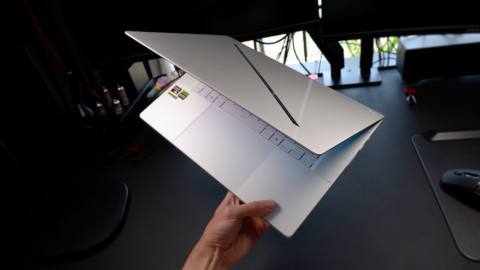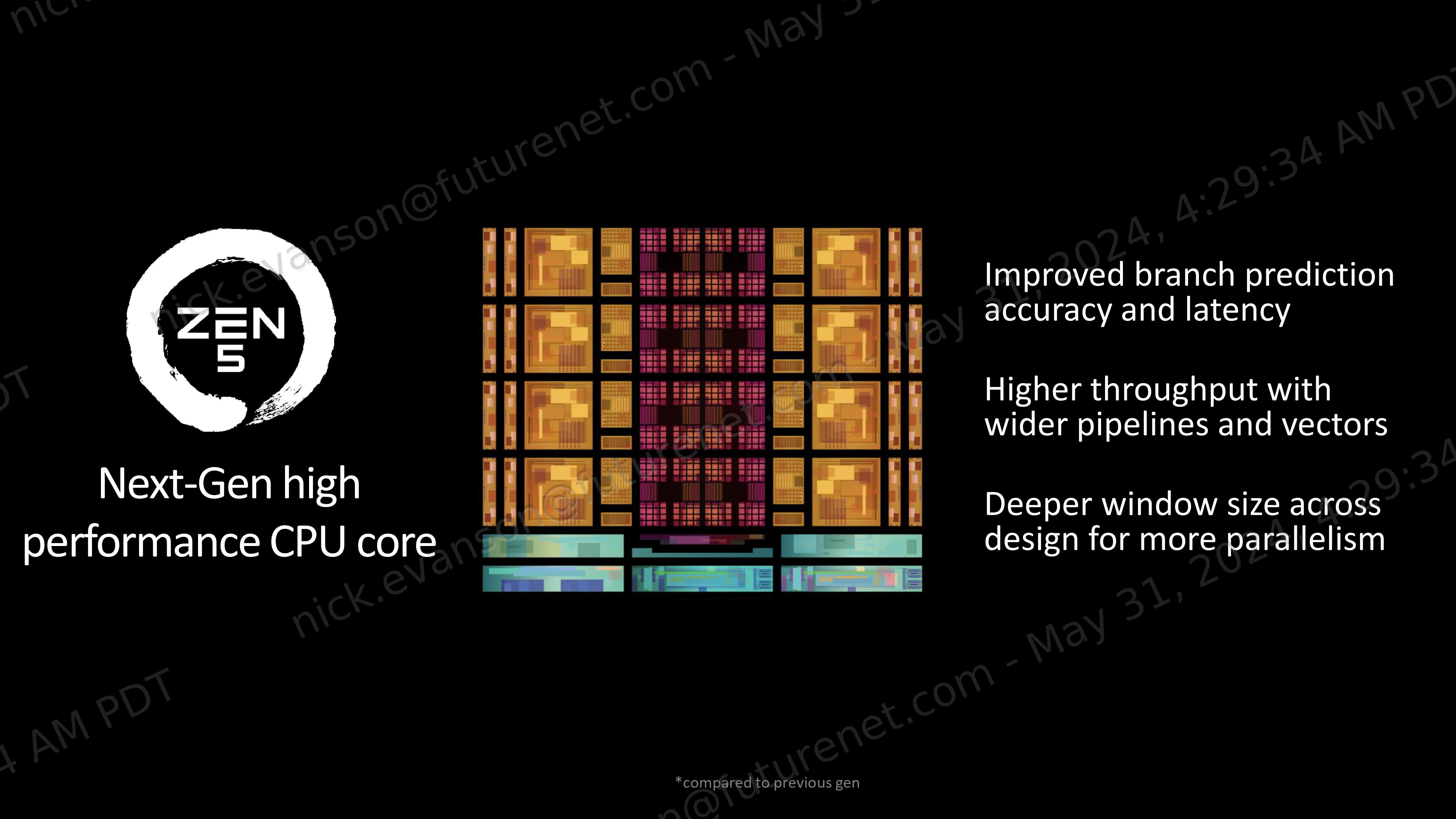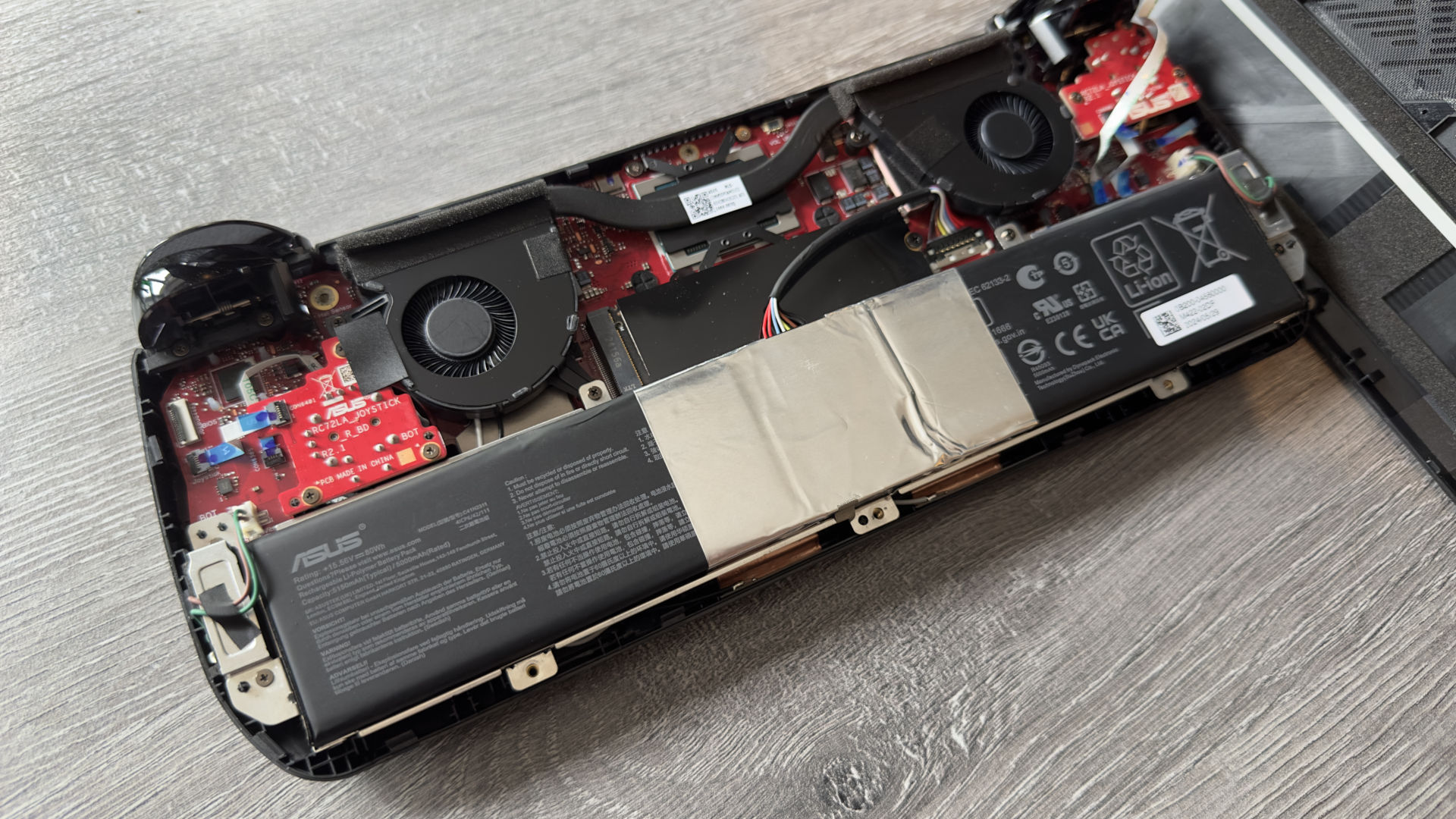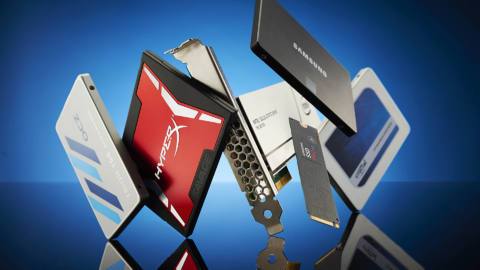Our first chance to test AMD's latest Zen 5 CPU architecture doesn't come in the form of a desktop chip. Rather a gaming laptop running a new AMD Ryzen AI 300-series processor—stuffed to the brim with new goodies.
My testing is carried out on the Asus ROG Zephyrus G16, fitted with the new AMD Ryzen AI 9 HX 370. This is one of the top chips out of the red team with 12 cores and 24 threads. It also comes with an integrated GPU with 16 Compute Units (CUs) of the new and improved RDNA 3.5 graphics architecture. To add to its already lengthy list of additions, this chip also houses an XDNA 2 powered AI processor, known as an NPU. Hence the clumsy addition of 'AI' to the name.
That's a lot of new stuff stuffed inside one singular slab of silicon—unlike Intel, AMD's latest chips are still monolithic. It's even more impressive what AMD has stuffed in this chip considering a 'default' TDP of 25 W and a max TDP of 54 W. The chip I'm testing given the full 54 W tether to play with.
AMD Ryzen AI 9 HX 370 specs

Codename: Strix Point
Cores: 12 (4x Zen 5, 8x Zen 5c)
Base clock: 2 GHz
Boost clock: Up to 5.1 GHz
L2 cache: 12 MB
L3 cache: 24 MB
Process node: TSMC 4nm
Configurable TDP range: 15 – 54 W (54 W tested)
iGPU: Radeon 890M
iGPU architecture: RDNA 3.5
Compute Units: 16 (1,024 cores)
iGPU clock: 2,900 MHz
NPU: Yes, 50 TOPS
Some of the cores within the HX 370 are not like the others. AMD is opting for a mix between Zen 5 and Zen 5c for its mobile lineup—what's known as a heterogeneous architecture. You might be familiar with the concept already as it's what Intel has been doing with its mobile and desktop chips. Except while Intel's P-cores and E-cores are very different, AMD's Zen 5 and Zen 5c cores are awfully alike.
There are four Zen 5 and eight Zen 5c cores in the HX 370, divided into two CCXs. One CCX with the four Zen 5 cores, and the other with eight Zen 5c cores. The 'compact' Zen 5c cores take up less room than full-fat Zen 5 cores, hence why AMD can stuff more of them into a single CCX than usual.
This compact design has a few benefits: not only can AMD stuff more cores onto a given die area, but these cores also consume less power than the full-size versions. Nothing comes for free in silicon land, however. To achieve these gains the Zen 5c cores have access to a much smaller shared L3 cache than the Zen 5 cores.
For the 24 MB of L3 cache shared between all 12 cores on the HX 370, only 8 MB is accessible by the eight Zen 5c cores. In a way that comes down to just 1 MB per core, but since it can be divvied out between any cores as required it won't necessarily work out that way.
The Zen 5 cores get to gobble up the remaining 16 MB between just four cores.

Otherwise, the Zen 5c cores are quite similar to their larger siblings. That's a savvy move on AMD's part, as will become clear once we move onto the benchmarks. These Zen 5c cores contribute to tremendous multithreaded performance in a relatively low-power mobile chip without hindering performance in more single-threaded tasks, such as gaming.
Before that, let's talk about the other new additions to this Ryzen AI chip. First, and most abundantly obvious, the 'AI' bit.
The HX 370 comes with an NPU powered by the XDNA 2 architecture. You might remember all the fuss AMD made about it at Computex this year, when it became apparent that AMD's NPU was bigger than Intel and Qualcomm's at 50 TOPS. What are those TOPS good for? Accelerating artificial intelligence on-chip, i.e. local AI processing.
Admittedly the carousel of applications that use on-chip AI acceleration is limited, and not all of those specifically utilise the NPU, if available. It's early doors for this sort of accelerator on-chip. You can push Photoshop to do it, and you can run some generative AI, though most of the time these sorts of AI software run all the heavy-duty stuff up in the cloud.
For gaming, at least, there's no immediate benefit to an NPU on the die. That said, when a killer app does arrive requiring local AI compute, you might be glad it's there. Then again there's also a mega AI accelerator built into most gaming machines, called a GPU.

The Zephyrus G16 has two GPUs. There's the Nvidia GeForce RTX 4070 mobile coming as a separate chip and the Radeon 890M included with the HX 370. We've seen plenty of RTX 4070 laptops, so that's not very important right now. What's more exciting is the Radeon 890M.
The 890M is using a brand new graphics architecture—maybe that's overselling it a little—a renewed graphics architecture. It's called RDNA 3.5 and it's mostly defined by a focus on improving mobile graphics performance. That's good news for the Zephyrus G16 and our hopes of genuinely impressive 1080p performance on a low-power chip or handheld gaming PC.
The 890M within the HX 370 is equipped with 16 CUs running at up to 2,900 MHz. That's a step-up over the very popular Radeon 780M, which comes with 12 CUs at 2,700 MHz. AMD provided further details about RDNA 3.5 at a recent event, and it effectively boils down to optimisations for low-power, low-shader operation, i.e. for use within an integrated GPU, not a discrete one.
AMD Ryzen AI 9 HX 370 performance
AMD told us to expect big uplifts in performance with Strix Point versus its most up-to-date competition thus far, Intel's Meteor Lake. Specifically, the company pointed to big gains between the HX 370 and the Core Ultra 9 185H, an Intel chip with more cores (16 > 12) but fewer threads (22 < 24).
AMD claims various productivity and creative application boons with its latest chips, such as in 3D modelling application Blender, which was touted previously to run up to 74% faster on the HX 370. Or Cinebench R24, claimed to be up to 47% quicker.
I can report from my own testing of these two chips—within the same overall model of laptop, in fact, the Zephyrus G16 (2024)—the HX 370 draws a confident lead over the Ultra 185H in a handful of tests.
In Cinebench R23, the HX 370 is 25% faster than the Ultra 185H when wielding only a single thread. That lends weight to AMD's claims of up to 16% improved IPC through those Zen 5 cores. The good news for AMD is that the HX 370 is also 25% faster in multithreaded tests, which is impressive considering the fewer physical cores on the Ryzen processor.
It's worth noting that all of AMD's cores are capable of simultaneous multithreading (SMT) and therefore has 24 threads to play with. That's two more than the Ultra 185H. Only the P-cores are capable of Hyper-Threading (Intel's version of SMT) on the Ultra 185H and thus it only has 22 at its disposal. Intel has more physical cores, sure, but fewer threads. Though I'd say for comparing two heterogenous processors, the HX 370 and Ultra 185H are about as close as we're going to get to comparable chips—at least until Lunar Lake arrives.
In 3DMark's Time Spy Extreme benchmark, taking only the CPU score, the HX 370 is 15% quicker.
I'm unable to make any direct comparisons on graphics performance as we've entirely different GPUs in each laptop—an RTX 4070 in one, RTX 4090 in the other; a higher TDP on one, lower TDP on the other—it wouldn't be a fair comparison. I cannot get the Blender benchmark scores, either. The damned thing won't run until AMD's chips are supported in the application, which happens with some pre-release hardware, and means I'm unable to test that lofty claim from the red team. With time we'll know how that shakes out.
AMD can claim another victory in the X264 benchmark. This is a measure of a CPU's ability to encode a 1080p video, four times over back-to-back, and is a multithreading-friendly benchmark. Unsurprisingly, with Strix Point's previous lead in multithreading, the HX 370 is able to claim a 13% improvement over the Ultra 185H.
The max power draw I measured this CPU running at while gaming was 54 W. Now compare that to another similar performing chip in testing, the Core i9 14900HX. This Intel chip is a much higher wattage CPU, which means we're seeing much lower power demands for similar performance with AMD's latest. The benefit of that is you can stuff a chip like this into a thinner, lighter laptop and still claim top performance—as per this Zephyrus model.
I generally saw lower CPU temperatures on the HX 370 than on the Ultra 185H within the same laptop design, which bodes well for any sort of gaming handheld built around one of AMD's latest chips.
AMD Radeon 890M performance
From the ROG Ally X to the Legion Go, many of the best handheld gaming PCs are built around a single iGPU: the Radeon 780M. Included with the popular Ryzen 7 7840U, and its follow-up, the Ryzen 7 8840U, this RDNA 3 iGPU was also included within the semi-custom Ryzen Z1 Extreme within the ROG Ally, ROG Ally X, and Lenovo Legion Go. It also made its way into heaps of gaming laptops, largely as a low-power alternative to a beefy Nvidia GPU.
The Radeon 890M is the first major upgrade on that design out of AMD. It's bigger, with 16 CUs to the 780M's 12, and features an improved RDNA 3.5 architecture—specifically designed to improve mobile graphics performance. That's 1,024 shader cores to 768—a 33% increase—and it should come as no surprise that this translates to much improved performance versus the 780M.
The 890M's increased shader count is almost perfectly mapped to the performance in F1 22. I recorded a 31% increase in average fps versus the 890M.
In Hitman's Dubai benchmark, it's 38% faster. I also saw a significant uplift in 1% low frame rates, which was consistent across multiple runs, but Hitman can be a little inconsistent when it comes to this metric.
In Horizon Zero Dawn these GPUs are squished closer together. The 890M still leads the way by a good 20% margin, but it's not quite representative of the performance uplift one would expect from 33% more cores.
The 890M is not only a bigger GPU, it comes with a design tailored to this sort of mobile workloads in RDNA 3.5. Our test chip, within the Zephyrus G16, also has more power budget to work with than those found in popular handheld gaming PCs. That should all make for a commanding lead, though clearly not every game is able to take full advantage. It may prove that in a more compact design, the 890M's lead will be reduced further.
Still, it'd be wrong to chastise this iGPU too harshly when it does offer a big uplift in mobile performance over its predecessor. These are considerable improvements to gaming performance, which, if replicated within a gaming handheld, should make for a much more consistent gaming experience on-the-go.
While we carry out most of our tests at largely the highest graphical presets, crank down the quality a touch and you can expect consistent and steady performance at 1080p from the 890M.
AMD Ryzen AI 9 HX 370 analysis

Would I be happy with a Ryzen AI processor inside my next gaming laptop? My answer is a resounding yes. The processing power on offer in a monolithic mobile processor is a marked improvement on what came before. Not for its new 'AI' nomenclature or NPU, which I've found tough to make use of in practice, but the improvements to the CPU and GPU components that PC gamers actually rely on.
This Zen 5/Zen 5c hybrid leaps ahead of AMD's previous generation and makes easy work of the Ultra 185H within the same Zephyrus chassis. This mix of cache-laden and cache-limited cores delivers both multithreaded and single-threaded performance to rival some of the most power-hungry laptop chips, while keeping power demands quite low. This bodes well for the Ryzen 9000-series, which we'll have to wait a little longer to get our hands on.
The fear that the addition of a new AI accelerator nixing any potential upgrades to the GPU component have been quashed, thanks to the four extra cores and improved RDNA 3.5 architecture on the HX 370. Clearly the higher core counts do wonders for gaming, even if the RDNA 3.5 architectural benefits are harder to quantify with a handful of benchmarks.
The 890M is most exciting in the context of gaming handhelds: even the smallest improvement between the 890M and the 780M amounted to a 20% improvement in frame rates. That is not to be sniffed at, and was on the lower end of the gains I experienced in testing. An increase in frame rates of roughly a third is also on the cards.
Moreover, this sort of GPU improvement should be convincing to many handheld PC manufacturers, many of whom are likely deciding when is the best time to release a new and improved model. We've had the sort of mid-generation upgrades in the Steam Deck OLED and ROG Ally X, though a true successor to either will be requiring more firepower at its disposal. Providing the 890M still delivers when confined to a smaller form factor, I believe it could be powerful enough to warrant a new wave of handhelds.

Though I'm yet to be convinced by AMD's new NPU—specifically its utility to an average user. Even less so from a PC gamer's perspective. One of the few remotely useful applications taking advantage of it is tangential to PC gaming at best. That's Amuse image generation, which is effectively Stable Diffusion running locally on your machine. It would be neat to run image generation locally on my laptop at least once, though I ran into multiple errors that prevented me from doing so. Issues aside, this just doesn't feel like a killer app for local AI, and the NPU doesn't feel to me like a must-have just yet.
Though I'm not torn up about it just yet. Whether you class the NPU as nice to have or practically pointless, it's included on an otherwise excellent gaming processor.
I should spend a moment to praise the Zephyrus G16, too. It's a prime specimen—I can see why Andy rated it so highly in his Zephyrus G16 2024 review. The AMD Ryzen AI 9 HX 370 and RTX 4070 combo offers performance at a frenetic pace, and pairs extremely well with the sleek chassis from Asus. If I had it my way, I'd keep this laptop as my daily driver.
It isn't a 16-inch laptop I'm hoping to get my hands on, though. It's a handheld gaming PC with the full complement of Ryzen AI 300-series features and power-savvy performance that doesn't drop the ball on frame rates. It'll come, I'm sure of it.
First things first, we need to see what Zen 5 can do with fewer power restrictions in the Ryzen 9000-series. Those chips are coming in just a couple of weeks, so stay tuned.






